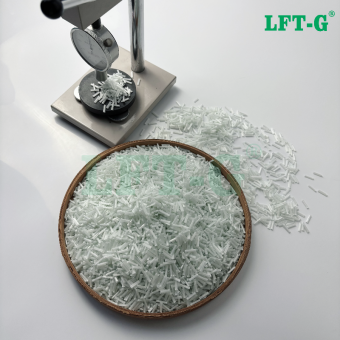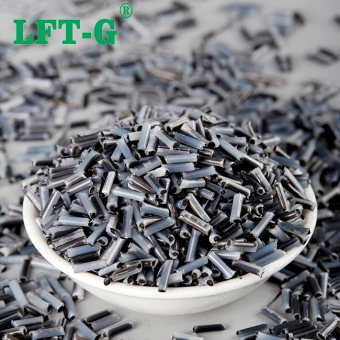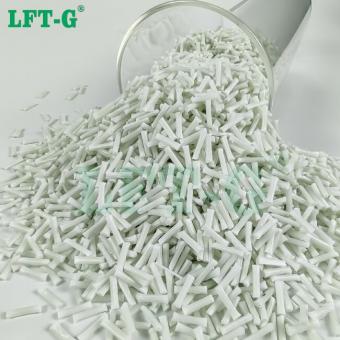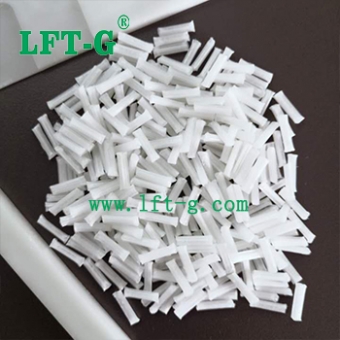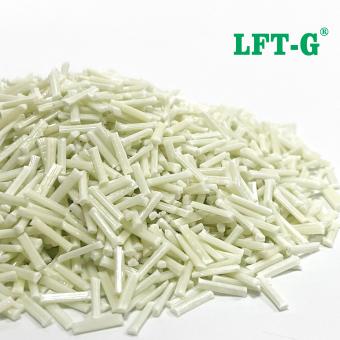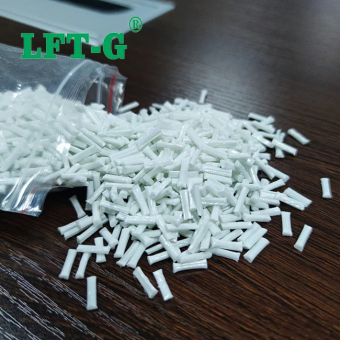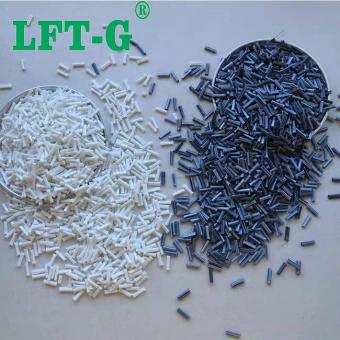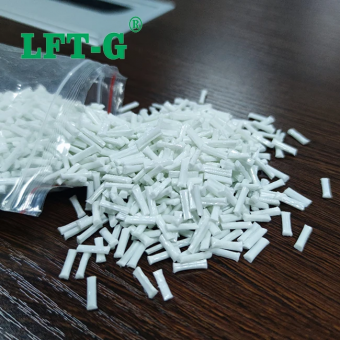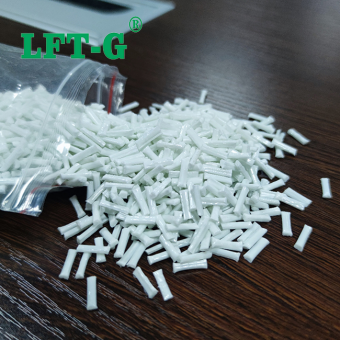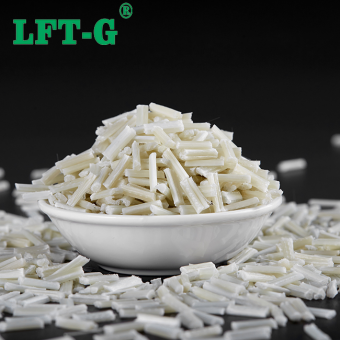Pbtプラスチック材料の改質 ガラス長繊維強化ポリブチレンテレフタレートpbt 高靭性、高衝撃非変形、電子および電気製品に適用高絶縁生産
-
厦門LFT-Gポリブチレンテレフタレート長ガラス繊維強化複合材料軽量化、衝撃強度、弾性率、材料強度の向上が求められる用途で、金属の代替として頻繁に使用されます。
- PBT改質プラスチックGF長ガラス繊維
- PBT熱可塑性エンジニアリングポリマー
- GFRP PBTの高靭性と剛性のサンプルが入手可能
- LFT PBTガラス繊維強化ポリマー良い価格
- 金属の代わりにPBTの高性能軽量
- 自動車部品向け低反りPA6
タグ :
-
LFT-G PBT長ガラス繊維強化熱可塑性樹脂コンパウンドペレットエンジニアリングPBTとは何ですか? ポリジブチルテレフタレートは、ジメチルテレフタレート (DMT) と 1,4-ブタンジオールによって重合された結晶性の熱可塑性エンジニアリング プラスチックです。 PBTは、熱可塑性ポリエステルプラスチックとも呼ばれます。さまざまな加工オペレーターが使用するために、一般に、添加剤の数が追加されたり、他のプラスチックと混合されたり、添加剤の割合が異なり、さまざまな仕様の製品を製造できます。 PBT は、その特殊な特性により、電気工学およびエレクトロニクスにおける特殊な用途に理想的な材料です。 1.機械的特性:高強度、耐疲労性、寸法安定性、クリープも小さい(高温条件下でも変化が少ない) 2.耐熱老化性: UL温度指数120~140℃の強化(屋外長期老化は可能) 3. 耐溶剤性:応力亀裂なし4. 水安定性: PBT は水中で分解しにくい 5. 絶縁性能:優れている (湿潤、高温でも安定した電気的性能を維持できる) グラスファイバーとは何ですか? ガラス繊維 (以前はガラス繊維として知られていました) は、優れた特性を備えた無機非金属材料です。木緑草、珪砂、石灰石、ドロマイト、ホウカルシウム、ホウマイト、7種類の鉱石を原料として、高温溶解、伸線、巻き取り、織りなどの工程で作られます。モノフィラメントの直径は数ミクロンから20ミクロン以上で、髪の毛の1/20~1/5に相当し、各繊維フィラメントは数百、場合によっては数千本のモノフィラメントで構成されています。グラスファイバー製品は、制御可能な範囲内では比較的環境に優しい製品です。 PBT は非常に弱い吸湿性を持っています。非強化PBTの引張強度は50MPa、ガラス繊維強化PBTの引張強度は170MPaです。 PBT は非常に早く結晶化するため、射出成形中に不均一な冷却により部品が曲がったり変形したりしやすくなります。一般的なPBT素材の収縮率は1.5%~2.8%です。 30% ガラス繊維強化された PBT 材料は、0.3% ~ 1.6% 収縮します。 1.耐高温性 試験後、温度が300℃に達しても、ガラス繊維の強度には影響がありません。 2. 高い引張強度 ガラス繊維の引張強度は標準状態で6.3~6.9g/d、湿潤状態で5.4~5.8g/dです。 3. 優れた電気絶縁性 ガラス繊維は電気絶縁性に優れ、断熱材や防火材にも使用される高レベルの電気絶縁材料です。 4. 燃焼 ガラス繊維は高温で溶かしてガラスビーズにすることができるため、建設業界の防火および管理の要件を満たします。 5. 優れた遮音性 ガラス繊維と石膏の組み合わせにより、優れた遮音効果を実現できます。 PBT にガラス繊維を充填したのはなぜですか? PBT にガラス繊維を添加することは、PBT を強化する一般的な方法です。ガラス繊維とPBT樹脂の結合力は良好で、PBT樹脂に一定量のガラス繊維を添加すると、PBT樹脂の耐薬品性、加工性などの本来の利点を維持できるだけでなく、機械的特性も大幅に向上できます。 PBT樹脂のノッチ感受性を克服します。 ガラス長繊維強化PBTコンパウンドの影響 01耐摩耗性 PBTは耐摩耗性に優れており、耐摩擦性や耐摩耗性が求められる場合に有利です。機械伝達部品やベアリングなどの用途では、PBTの耐摩耗性が有効に活用されています。 02機械的特性 PBTは改質後も優れた機械的特性を示します。高い強度と耐疲労性、良好な寸法安定性、低いクリープを備えています。そのため、より大きな負荷に耐え、長期間使用する必要がある部品にはPBTがよく使用されます。 03熱安定性 PBTは熱安定性に優れ、高温条件下でも性能を維持でき、熱分解や変形が起こりにくい素材です。このため、PBT は、電子および電気機器のワイヤ コネクタや絶縁部品など、高温の作業環境に耐えるのに理想的な選択肢となります。 04難燃性 PBTは改質後も優れた難燃特性を有しており、一部の特殊分野の難燃要件を満たすことができます。 UL94 は、材料の難燃特性をテストするための規格です。 PBT エンジニアリング プラスチックの難燃グレードは UL94 V-0 レベルに達することができます。これは、燃焼試験における PBT サンプルの燃焼時間が 10 秒未満であり、燃焼プロセス中に難燃剤が存在しないことを意味します。液だれ現象。このため、PBT成形材料は電子・電�もっと見る
-
-
-
-
-
LFT PBT 充填長ガラス繊維強化熱可塑性バージン顆粒射出成形 PBT リサイクル材料 PBT コンパウンド材料。
- PBT樹脂変性ポリマーの高い機械的特性
- pbt GF10 電気コネクタの価格
- プラスチック pbt GF40 GF30 ロングカットファイバー
- kgあたりのpbtの価格 PBT化合物は良い価格です
- 射出成形自動車部品用 pbt
- 優れた防水性のPBT顆粒
タグ :
-
アモイ LFT 高強度 PBT 強化プラスチック長ガラス繊維充填コンパウンドPBT素材 ポリブチレン テレフタレート (PBT) は熱可塑性ポリエステルであり、トップ 5 エンジニアリング プラスチックの 1 つです。PBTは優れた総合性能を持ち、最も強靱なエンジニアリングプラスチックの1つであり、高い寸法安定性、良好な耐薬品性、優れた電気絶縁性、良好な機械的特性と弾性、低吸水性などを備えています。 PBT充填 ガラス長繊維コンパウンド PBT (ポリブチレンテレフタレート) はポリエステルベースのプラスチックであり、ガラス繊維は通常、機械的特性を高めるために繊維の形でプラスチックに添加される強化材です。PBT をガラス繊維と組み合わせると、次のような効果が生じます。1. 強度と剛性の向上: ガラス繊維は優れた強度と剛性を有しており、PBT に添加するとプラスチックの機械的特性を大幅に向上させることができます。これにより、ガラス繊維を含む PBT の材料は、力や応力が加わったときにより強くて堅くなり、変形したり破損したりしにくくなります。2.耐熱性の向上:ガラス繊維は融点が高く、耐熱性能が優れています。PBT にガラス繊維を添加すると、PBT の耐熱性が向上し、高温でも優れた性能を維持し、軟化や溶融を防ぐことができます。3. 耐食性の向上:ガラス繊維は耐食性に優れており、PBTに添加することで薬品、溶剤などの腐食性媒体に対する耐性が向上します。これにより、ガラス繊維を使用した PBT は、一部の特殊な環境においてより長い耐用年数を実現します。4.絶縁性能の向上:PBT自体が優れた絶縁性能を持っていますが、ガラス繊維の添加によりPBT材料の絶縁性能がさらに向上します。これにより、ガラス繊維を使用した PBT は電気および電子用途により適しており、電流を効果的に絶縁し、漏れや電磁干渉を低減できます。全体として、ガラス繊維を含む PBT はプラスチックの機械的特性、耐熱性、耐食性、絶縁特性を向上させることができ、さまざまな用途でより広く使用されるようになります。ただし、材料の性能は、特定のガラス繊維の含有量と添加プロセスによって異なる場合があります。 ファイバー仕様 学年 ファイバー仕様 特徴 応用 長さ 色 パッケージ 一般グレード 20%-60% 高い靭性、低反り 電子機器、機械部品、等 約12mm、 またはカスタマイズされた ナチュラルカラー、 またはカスタマイズされた 25kg/袋 LGFとSGFの違い 短いガラス繊維粒子:サイズは約 3 ~ 4 mm、長さと幅の比は 50 ~ 250長いガラス繊維粒子:サイズは約 10 ~ 12 mm、アスペクト比 > 400さらに、2 種類の粒子におけるガラス繊維の分布も異なります。 SGFと比較して、LGFは剛性、強度、弾性率が向上しており、特にノッチ付き衝撃性能が質的に飛躍しています。 応用 参考用のデータシート 私たちについて アモイ LFT 複合プラスチック有限公司は、LFT&LFRTに焦点を当てたブランド企業です 。ガラス長繊維シリーズ (LGF ) および炭素長繊維シリーズ (LCF )。同社の熱可塑性 LFT は、LFT-G 射出成形および押出成形に使用できるほか、LFT-D 成形にも使用できます。お客様のご要望に合わせて製作可能です: 長さ5~25mm。同社の長繊維連続浸透強化熱可塑性プラスチックは ISO9001&16949 システム認証に合格しており、製品は多くの国内商標と特許を取得しています。
- PBT reisn コンポジット lgf 30 ベストプライス
- 自動車部品用長ガラス繊維強化PBT
- バージンホワイトPBTはリサイクル可能LGF
- 熱可塑性プラスチック pbt lft 中国製卸売
- フィラーLGFを使用した高性能PBT
- PBT複合プラスチックメーカー直販
タグ :
-
アモイLFT PBT改質材料充填長ガラス繊維高性能オリジナルカラーPBTとは何ですか? ポリブチレン テレフタレート (PBT) は熱可塑性ポリエステルであり、5 つのエンジニアリング プラスチックの 1 つです。 PBTは優れた総合性能を持ち、最も強靱なエンジニアリングプラスチックの一つであり、高い寸法安定性、優れた耐化学腐食性、優れた電気絶縁性、優れた機械的特性と弾性、低吸水性などを備えています。 PBT-LGFとは何ですか? PBT はエンジニアリングプラスチックの 1 つであるため、実用化分野での対応する要件を満たすためには、ほとんどの PBT を改質する必要があります。PBT改質は主に難燃性PBT、ガラス繊維強化難燃性PBT、ガラス繊維強化PBTに分けられます。 変性PBT材料は主に照明分野(LEDランプシェルなど)、電子・電気分野(リレーシェルやスピナー、ソケット、光ファイバーコネクタなど)、自動車製造分野(ジャンクションボックス、点火系部品、社外ドアハンドル等)。 ガラス長繊維とガラス短繊維の違い 長いガラス繊維の長さは 6 ~ 25 mm ですが、ステープル ファイバーは通常 6 mm 未満、さらには 0.2 ~ 0.6 mm の間です。 ガラス長繊維は機械的特性においてより優れた性能を発揮します。大型製品や構造部品に適しています。短繊維に比べて1~3倍(靭性)が高く、引張強さ(強度・剛性)は0.5~1倍になります。 PBT-LGFの用途は何ですか? 照明業界では、ほとんどのランプシェルは強化難燃性 PBT 素材に使用されており、その性能要件には、加工と成形が容易で、優れた機械的特性、高温および低温サイクル耐性、難燃性レベル UL94 3.0mm または 1.5mm V0 が含まれます。 、高温耐性、黄変防止効果は良好です。その外観には、透明な色または磁器の白い陰影、滑らかな表面、浮遊繊維がないことが必要です。 自動車製造分野では、変性PBTは主に自動車ワイパーブラケット、自動車ヘッドライト照明リング、自動車トランスミッションギアボックス、フロントガラスピラー、モーターシェルなどに使用されています。 TDS は参考のみ 射出成形 私たちについて アモイ LFT 複合プラスチック有限公司は、LFT&LFRT に焦点を当てたブランド企業です。長ガラス繊維シリーズ (LGF) および長炭素繊維シリーズ (LCF)。同社の熱可塑性 LFT は、LFT-G 射出成形および押出成形に使用できるほか、LFT-D 成形にも使用できます。お客様のご要望に応じて長さ5~25mmまで製作可能です。同社の長繊維連続浸透強化熱可塑性プラスチックは ISO9001&16949 システム認証に合格しており、製品は多くの国内商標と特許を取得しています。 お問い合わせ
- ポリブチレンテレフタレート複合材
- PBT長ガラス繊維複合材料
- フィラーを添加したpbt熱可塑性樹脂
- pbt lgf 化合物工業用 reisn
- lgf pbt 樹脂熱可塑性化合物
- 金属の代わりにPBT強化材料
タグ :
-
アモイ LFT-G ポリブチレンテレフタレートには長ガラス繊維で強化された PBT 化合物が含まれています製品グレード:一般グレード 繊維仕様: 20%-60% 製品特徴:高靭性、低反り 製品用途:電子機器、機械部品等
- PBT樹脂の優れた機械的強度
- 電子機器では金属の代わりにPBT-GFが使用されています
- サンプル利用可能 PBT 自社工場製、良い価格
- ナチュラルカラー PBT 充填 LGF 20%-60%
- 繊維充填材射出成形PBT
- 高い靭性と強度のPBTグラスファイバー
タグ :
-
-
lft-g PBT 変性プラスチック充填長繊維高性能ナチュラルカラー工業用射出成形PBT素材 ポリブチレンテレフタレート (PBT) は、テレフタル酸ジメチル (DMT) と 1,4 ブタンジオール (1,4-ブタンジオール) を重合して作られる結晶性の熱可塑性エンジニアリング プラスチックです。PBT樹脂は-CH2-鎖の成長により分子鎖が曲がりやすいため、ガラス転写温度がPETよりも低く、結晶化速度が速くなります。 PBT は熱可塑性ポリエステルプラスチックとも呼ばれ、さまざまな加工産業に適用でき、一般に多かれ少なかれ添加剤を追加したり、添加剤の割合が異なる他のプラスチックとブレンドしたりして、製品のさまざまな仕様で製造できます。PBT は耐熱性、耐候性、耐薬品性、良好な電気特性、低吸水性、良好な光沢を備えているため、電子・電気製品、自動車部品、機械、家庭用品などに広く使用されています。 PBT の下流用途には、自動車、エレクトロニクスが含まれます 。 /電気機器、機械産業。 参考用のデータシート 応用 LGFとSGF ガラス長繊維強化材のメリット ガラス繊維強化プラスチックは、元の純粋なプラスチックにガラス繊維やその他の添加剤を加えて、材料の使用範囲を向上させたものです。一般的に言えば、ガラス繊維強化材料のほとんどは製品の構造部品に使用されており、PP、ABS、PA66、PA6、PC、POM、PPO、PET、PBT、 PPSなど。 利点 ガラス繊維強化後のガラス繊維は高温に強い材料であるため、強化プラスチック、特にナイロンプラスチックの耐熱温度はガラス繊維を使用しない前よりもはるかに高くなります。 ガラス繊維強化後、ガラス繊維の添加によりプラスチックのポリマー鎖の相互運動が制限されるため、強化プラスチックの収縮が大幅に減少し、剛性が大幅に向上します。 ガラス繊維強化後、強化プラスチックは応力亀裂が発生せず、同時にプラスチックの耐衝撃性が大幅に向上します。 ガラス繊維強化後のガラス繊維は高強度材料であり、引張強度、圧縮強度、曲げ強度などのプラスチックの強度も大幅に向上します。 ガラス繊維強化後、ガラス繊維やその他の添加剤の添加により、強化プラスチックの燃焼性能は大幅に低下し、ほとんどの材料は発火できなくなり、一種の難燃材料となります。 倉庫と研究室 お客様と私たち カタログもっと見る

 Eメール
Eメール 日本語
日本語 English
English français
français Deutsch
Deutsch русский
русский italiano
italiano español
español português
português العربية
العربية 한국의
한국의 中文
中文




